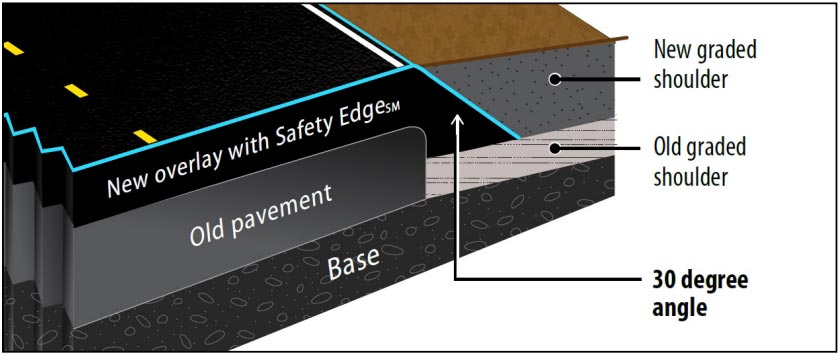U.S. Department of Transportation
Federal Highway Administration
1200 New Jersey Avenue, SE
Washington, DC 20590
202-366-4000
The SafetyEdgeSM technology shapes the edge of the pavement at approximately 30 degrees from the pavement cross slope during the paving process. This safety practice eliminates the potential for vertical drop-off at the pavement edge, has minimal effect on project cost, and can improve pavement durability by reducing edge raveling of asphalt.
Rural road crashes involving edge drop-offs are 2-4 times more likely to include a fatality than other crashes on similar roads.1 Vehicles may leave the roadway for various reasons ranging from distracted driver errors to low visibility, or to the presence of an animal on the road. Exposed vertical pavement edges can cause vehicles to become unstable and prevent their safe return to the roadway. The SafetyEdgeSM gives drivers the opportunity to return to their travel lane while maintaining control of their vehicle.
The SafetyEdgeSM technology only requires adding one of several commercially available devices to the screed or endgate when placing hot-mix asphalt. Forms for shaping the edge of concrete pavement are simpler and can be made on site by the contractor. Some agencies allow the SafetyEdgeSM to remain exposed while a segment is under construction, unlike conventional pavement edges. However, before construction ends, agencies should bring the adjacent roadside flush with the top of the pavement for both the SafetyEdgeSM and traditional pavement edge. Over time, regardless of the edge type, the edge may become exposed due to settling, erosion, and tire wear. When this occurs, the gentle slope provided by the SafetyEdgeSM is preferred versus the traditional vertical pavement edge.
Transportation agencies should develop standards for implementing the SafetyEdgeSM systemwide on all new asphalt paving and resurfacing projects where curbs and/or guardrail are not present, while also encouraging standard application for concrete pavements.

Cross-section view of an overlay with the SafetyEdgeSM. Source: FHWA-SA-17-044
Sources
1. Hallmark et al. Safety Impacts of Pavement Edge Drop-offs, (Washington, DC: AAA Foundation for Traffic Safety: 2006), p 93.
2. Donnell et al. Development of Crash Modification Factors for the Application of the SafetyEdgeSM on Two-Lane Rural Roads. FHWA-HRT-17-081, (2017).
3. Safety Effects of the SafetyEdgeSM, FHWA-SA-17-044, (2017).
Filter countermeasures by focus area, crash type, problem identified, and area type.
